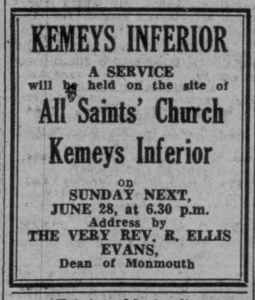All Saint's Chuch Kemeys Inferior
The lost church of Kemeys Inferior

Nestled on the banks of the River Usk, just opposite Kemeys House, stood All Saint’s Church of Kemeys Inferior. For centuries it played a pivotal role in the lives of the local community, including our family – the Skinners of Abernant Farm. Just a short walk from their home, the Skinners were regular worshippers, marking life’s milestones within its historic walls.
All Saint’s served as the setting for countless Skinner family baptisms, weddings, funerals, and burials. Notably, in 1912, our grandfather Donald Skinner and his six siblings were baptised together at the church. Their father, James Skinner, was deeply involved in church life, serving as a churchwarden for many years until his death in 1927. Beyond his duties at All Saint’s, James also chaired the Parishioners and Friends of Kemeys Inferior and Langstone.
The origins of All Saints’ Church remain shrouded in mystery, though it served the community for at least 500 years. Its heritage was evident in its fine Roman arch and a 1383 reference to the “Parson of Cammeys” in the Llandaff Diocesan Register. Some historians speculate that the Cemeis granted to Llandaff in the 7th century by Rhodri may have been this very church, further deepening its significance.
A detailed description of the church appears in Kelly’s Directory of Monmouthshire (1891): “The church of All Saints is a building of native stone in the Early English style, consisting of chancel, nave, north aisle, south porch, and a western turret containing one bell: there are 80 sittings. The register dates from the year 1701. The living is a rectory, yearly value from the year charge £148, in the gift of Holford Cotton Risley Esq. J.P. of Deddington, Oxfordshire, and held since 1886 by the Worshipful George Woods M.A. of University College, Oxford, Chancellor of Llandaff, who resides at Penhow. Parish Clerk: William Collins.”


In 1850, the doors to the rood-loft at All Saint’s were opened, revealing piles of rubbish, bones, and the remains of a carved wooden figure of Christ. Known as the Kemeys Christ, this rare artifact is considered an important example of pre-Reformation devotional art. Additional fragments, including skulls and bones, were uncovered during church repairs in 1886, further deepening the site’s historical intrigue.
Scientific examination of the crucifix revealed that the wooden object was once richly decorated in vibrant colours and magnificent gold leaf. The figure was initially displayed at Caerleon Museum and later transferred in 1930 to Amgueddfa Cymru – National Museum Wales. Art historians date the Kemeys Christ to the late 13th century, making it an invaluable connection to Britain’s medieval past.
By 1932, All Saints’ Church faced grave challenges as the River Usk threatened to claim it, with only five feet separating the building from a sheer 50-foot drop. Parishioners observed crumbling along the riverbank, while Reverend D. Dudlyke speculated that an underground spring beneath the church, rather than erosion, might be to blame. The Western Mail reported on the perilous situation, bringing wider attention to the church’s uncertain fate.
Despite the danger, the tiny church – one of the smallest in the country with just 40 seats – continued to attract thousands of visitors each year. The Bishop of Monmouth convened an emergency meeting to address the crisis, but although the church remained in use for another 27 years, its fate was sealed. On September 15th 1959, the Diocese of Monmouth declared All Saints’ Church unsafe and made the difficult decision to close it permanently.


The final burial recorded in the church’s register took place on June 2nd 1959, for Howard Charles Badger of Little Kemeys. A courageous man, Howard spent his final years witnessing the slow disintegration of his beloved church, doing his best to protect it from vandals who shattered windows and hacked at the woodwork. He captured his sorrow in a poem titled Keymes Church, describing it as “disintegrating in decay upon its fast eroding perch.” Tragically, between 1960 and 1962, the derelict church was demolished with some of its stone repurposed for the extension of the cathedral at Stow Hill.
In 1969 part of the graveyard was the subject of a compulsory purchase order and used for the construction of the A449. Today, what remains of the church is a scheduled ancient monument under the protection of Cadw, with remnants of the church walls still standing at about one meter high. Some original flagstones and gravestones endure, offering a tangible link to its storied past. However, public access is restricted, and visitors must seek permission from a neighboring landowner to explore the site.
The demolition of All Saint’s deeply affected the families of those buried there. The graves stayed in situ until 1970, when many remains, including those of our great-grandparents James and Rosa Skinner and James’s parents John and Jessie Skinner, were reburied at St Andrew’s Church in Tredunnock. Thankfully, these reburials included their original headstones. However, some were less fortunate, with remains moved to a mass grave. A special service was held on the site of All Saint’s to mark the exhumations.
The following extract is from a poignant poem, written by Gwen Skinner, it captures the sorrow of this loss: “And soon some unknown hands will lift these dear old bones and carry them away. Away to high Tredunnock’s ordered plot.”


All Saint’s Church continues to hold an important place in our family’s history. Though its walls no longer stand, its story and significance live on. The site remains an important link to the medieval ecclesiastical history of the region, and its legacy offers insights into both the past and the lives it touched.
If you have stories, memories, or photographs of All Saint’s Church, Kemeys Inferior, we’d love to hear from you. Please email us at research@skinnerfamilyhistory.com to help preserve and share its rich history.
